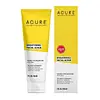What's inside
What's inside
 Key Ingredients
Key Ingredients

 Benefits
Benefits

 Concerns
Concerns

 Ingredients Side-by-side
Ingredients Side-by-side

Water
Skin ConditioningKaolin
AbrasiveDecyl Glucoside
CleansingZea Mays Seed Flour
AbrasiveHoney
HumectantLactic Acid
BufferingGlycerin
HumectantTitanium Dioxide
Cosmetic ColorantSodium Lactate
BufferingJuglans Regia Shell Powder
AbrasiveCitrus Medica Fruit Juice Extract
Skin ConditioningXanthan Gum
EmulsifyingOlea Europaea Leaf Extract
PerfumingCaprylic/Capric Triglyceride
MaskingNiacin
SmoothingGlycyrrhiza Glabra Root Extract
BleachingCucumis Sativus Fruit Extract
EmollientEucalyptus Globulus Leaf Extract
PerfumingRosmarinus Officinalis Leaf Extract
AntimicrobialMentha Piperita Leaf Extract
Skin ConditioningSalix Alba Bark Extract
AstringentMagnesium Ascorbyl Phosphate
AntioxidantPotassium Sorbate
PreservativeSodium Benzoate
MaskingDiacetyl Boldine
Skin ConditioningEDTA
Water, Kaolin, Decyl Glucoside, Zea Mays Seed Flour, Honey, Lactic Acid, Glycerin, Titanium Dioxide, Sodium Lactate, Juglans Regia Shell Powder, Citrus Medica Fruit Juice Extract, Xanthan Gum, Olea Europaea Leaf Extract, Caprylic/Capric Triglyceride, Niacin, Glycyrrhiza Glabra Root Extract, Cucumis Sativus Fruit Extract, Eucalyptus Globulus Leaf Extract, Rosmarinus Officinalis Leaf Extract, Mentha Piperita Leaf Extract, Salix Alba Bark Extract, Magnesium Ascorbyl Phosphate, Potassium Sorbate, Sodium Benzoate, Diacetyl Boldine, EDTA
Water
Skin ConditioningAloe Barbadensis Leaf Juice
Skin ConditioningGlycerin
HumectantSodium Methyl Cocoyl Taurate
CleansingJuglans Regia Shell Powder
AbrasiveKaolin
AbrasiveSodium Lauroamphoacetate
CleansingCitrus Limon Peel
MaskingSodium PCA
HumectantSodium Lauroyl Lactylate
EmulsifyingGlyceryl Laurate
EmollientSodium Cocoyl Isethionate
CleansingOlea Europaea Fruit Oil
MaskingLaminaria Digitata Powder
Skin ConditioningLilium Candidum Leaf Cell Extract
Skin ConditioningEuterpe Oleracea Fruit Extract
Rubus Fruticosus Fruit Extract
AstringentRosa Canina Fruit Extract
AstringentPunica Granatum Extract
AstringentCalendula Officinalis Flower Extract
MaskingChamomilla Recutita Flower Extract
MaskingAspalathus Linearis Leaf Extract
Skin ConditioningCI 75810
Cosmetic ColorantChondrus Crispus Extract
Skin ConditioningArgania Spinosa Callus Culture Extract
Skin ConditioningChlorella Vulgaris Extract
Skin ConditioningHelianthus Annuus Seed Oil
EmollientCymbopogon Flexuosus Leaf Oil
MaskingMentha Viridis Leaf Oil
AstringentSalvia Sclarea Oil
MaskingLavandula Hybrida Oil
EmollientCellulose Gum
Emulsion StabilisingSodium Levulinate
Skin ConditioningGluconolactone
Skin ConditioningPotassium Sorbate
PreservativeWater, Aloe Barbadensis Leaf Juice, Glycerin, Sodium Methyl Cocoyl Taurate, Juglans Regia Shell Powder, Kaolin, Sodium Lauroamphoacetate, Citrus Limon Peel, Sodium PCA, Sodium Lauroyl Lactylate, Glyceryl Laurate, Sodium Cocoyl Isethionate, Olea Europaea Fruit Oil, Laminaria Digitata Powder, Lilium Candidum Leaf Cell Extract, Euterpe Oleracea Fruit Extract, Rubus Fruticosus Fruit Extract, Rosa Canina Fruit Extract, Punica Granatum Extract, Calendula Officinalis Flower Extract, Chamomilla Recutita Flower Extract, Aspalathus Linearis Leaf Extract, CI 75810, Chondrus Crispus Extract, Argania Spinosa Callus Culture Extract, Chlorella Vulgaris Extract, Helianthus Annuus Seed Oil, Cymbopogon Flexuosus Leaf Oil, Mentha Viridis Leaf Oil, Salvia Sclarea Oil, Lavandula Hybrida Oil, Cellulose Gum, Sodium Levulinate, Gluconolactone, Potassium Sorbate
 Reviews
Reviews

Alternatives
Ingredients Explained
These ingredients are found in both products.
Ingredients higher up in an ingredient list are typically present in a larger amount.
Glycerin is already naturally found in your skin. It helps moisturize and protect your skin.
A study from 2016 found glycerin to be more effective as a humectant than AHAs and hyaluronic acid.
As a humectant, it helps the skin stay hydrated by pulling moisture to your skin. The low molecular weight of glycerin allows it to pull moisture into the deeper layers of your skin.
Hydrated skin improves your skin barrier; Your skin barrier helps protect against irritants and bacteria.
Glycerin has also been found to have antimicrobial and antiviral properties. Due to these properties, glycerin is often used in wound and burn treatments.
In cosmetics, glycerin is usually derived from plants such as soybean or palm. However, it can also be sourced from animals, such as tallow or animal fat.
This ingredient is organic, colorless, odorless, and non-toxic.
Glycerin is the name for this ingredient in American English. British English uses Glycerol/Glycerine.
Learn more about GlycerinYou might know this ingredient as walnut shell powder. It is an abrasive used as a physical exfoliator.
Abrasives are physical exfoliants used to get rid of dead cell buildup on your skin. Physical exfoliators have a bad reputation due to the myth that they give your face tiny cuts. This is untrue.
Like any exfoliant, using this ingredient can disrupt your skin barrier. This can lead to breakouts, irritation, and dryness. It is critical to be gentle when using any type of exfoliator.
If you want to use a chemical exfoliator instead, check out glycolic acid.
Learn more about Juglans Regia Shell PowderKaolin is a clay. It is used for oil control and to help minimize pores. Like other clays, kaolin has the ability to absorb excess sebum or oil. This can help clean out pores and mattify the skin.
Some types of kaolin may have exfoliating properties. When water is added to kaolin, it becomes a paste with small abrasive particles.
Most kaolin is a white color, but may be pink/orange/red depending on where it comes from.
The name 'kaolin' comes from a Chinese village named 'Gaoling'. Kaolin clay comes from rocks rich in kaolinite. Kaolinite, the mineral, has a silicate layered structure. Kaolinite is formed from chemical weathering of aluminum siilicate minerals.
Besides skincare, kaolin is commonly used to make glossy paper, in ceramics, toothpaste, and as medicine to soothe stomach issues.
Learn more about KaolinPotassium Sorbate is a preservative used to prevent yeast and mold in products. It is commonly found in both cosmetic and food products.
This ingredient comes from potassium salt derived from sorbic acid. Sorbic acid is a natural antibiotic and effective against fungus.
Both potassium sorbate and sorbic acid can be found in baked goods, cheeses, dried meats, dried fruit, ice cream, pickles, wine, yogurt, and more.
You'll often find this ingredient used with other preservatives.
Learn more about Potassium SorbateWater. It's the most common cosmetic ingredient of all. You'll usually see it at the top of ingredient lists, meaning that it makes up the largest part of the product.
So why is it so popular? Water most often acts as a solvent - this means that it helps dissolve other ingredients into the formulation.
You'll also recognize water as that liquid we all need to stay alive. If you see this, drink a glass of water. Stay hydrated!
Learn more about Water